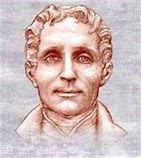 |
| Page of Braille writing. |
 |
| House where Louis Braille was born in 1809 in Coupvray, France. |
 |
| Louis Braille |
 |
| The six-dot code for letters, numbers and punctuation. |
 |
| The dollar coin was issued in the United States in 2009 to honor Louis Braille on his bicentennial birthday. |
No comments:
Post a Comment